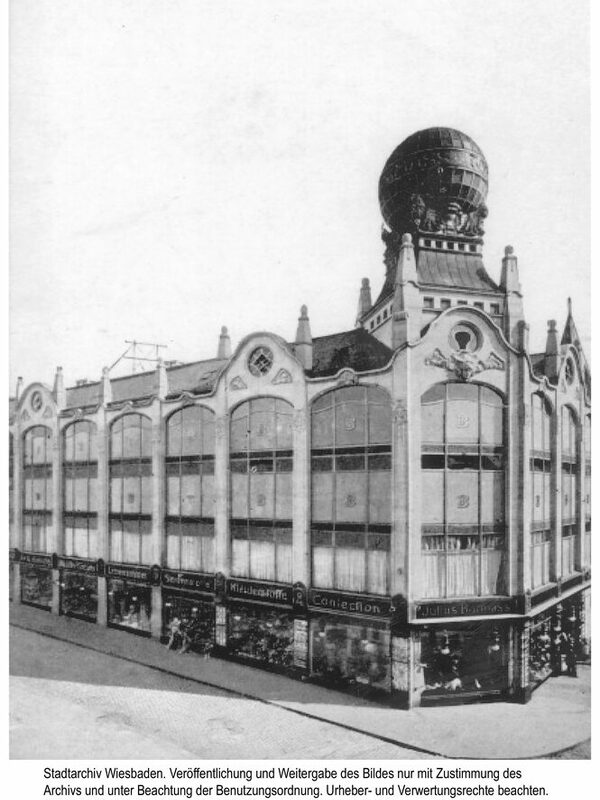Department stores
In 1883, Julie and Seligmann Blumenthal founded the department store "S. Blumenthal & Co." at Kirchgasse 49, the corner building to Schulgasse. From 1904, the department store resided in the new building at Kirchgasse 39-41 and became the largest and most elegant department store in Wiesbaden at the time. In 1920, the Blumenthal family employed around 250 people. In 1935, the department store had to be closed by its Jewish owners due to boycott measures. In 1948, Karstadt took over the building with the department store.
In 1892, Julius Bormass opened his department store on Mauritiusplatz, mainly selling clothing, bedding and haberdashery. The department store, built in Art Nouveau style, closed off the south side of the square and dominated the corner of Kirchgasse and Schulgasse. A striking feature was the "globe" crowning the rounded corner façade. In 1926, the department store was transferred to the Jasching company and a year later to the Lindemann & Co. department store. In 1929, Karstadt AG merged with Lindemann & Co. In 1932, the department stores were renamed Karzentra. After the Second World War, the Americans confiscated the building until 1955, after which it was redesigned and modernized; in 1964, Karzentra was renamed Karstadt. Four years later, the building fell victim to the pickaxe. The site was given to the city and Mauritiusplatz was redesigned.
In 1908, the third department store, Modehaus M. Schneider, built by architect Martin Dülfer (1859-1942), was established directly next to Blumenthal in Kirchgasse. In 1954, after the merger with Karstadt, this department store on Kirchgasse had a 72 m long frontage and ten shop windows. In 1957, Karstadt acquired the department store, the house at Schulgasse 8 and in 1964, no. 4. In 1965, the houses at Schulgasse 2, Kirchgasse 43 and Neugasse 6 with the historic fire station by Felix Genzmer were added. In 1968, Karstadt presented itself as Wiesbaden's largest retailer with five floors on the Kirchgasse 35-43 site and the parking garage on Neugasse. During the redesign, the sidewalks disappeared in the new arcades. The façade was redesigned in 1987 and 2004 and Karstadt was widened into Schulgasse.
In 1949, the Wiesbaden branch of the Hertie (originally the Hermann Tietz company) "Volkswarenhaus" opened its premises on the corner of Kirchgasse and Luisenstraße. In 1956, the department store moved to the opposite side of Kirchgasse. The first extension of the new building took place in 1961; by 1972, the department store had expanded as far as Schwalbacher Straße. After Schwalbacher Straße was widened, the connecting glass bridge was built to the building opposite with stores and the parking garage. In 1994 Karstadt took over the Hertie department store and in 2006 the conversion and new construction of the entire department store area between Dotzheimer Straße and Kirchgasse into the Luisenforum began, which opened its doors on September 2, 2008.
The K. C. & A. Brenninkmeyer has been in existence since 1955. In 2005, the building was remodeled, the arcades were built over and the façade was adapted to the new Wiesbaden shopping street with a contemporary glass construction.
Until 1967, the Köster department store stood on the corner of Kirchgasse and Friedrichstraße. In 1967, the Horten department store opened a branch there with salesrooms extending to Schwalbacher Straße. The façade on Schwalbacher Straße was designed by the architect Egon Eiermann (1904-1970). From 1985-97, the department store was known as Carsch-Haus until Galeria Kaufhof opened after it was remodeled. '
In 1971, Kaufhalle AG bought the houses at Langgasse 5, 7 and 9 and others in Wagemannstraße and had them demolished for a new building. In May 1973, the "most modern department store in Germany" was opened. In 1999, the Kaufhalle became the Sportarena, which closed in 2017.
Literature
Sigrid Russ, editor, Denkmaltopographie Bundesrepublik Deutschland. Cultural monuments in Hesse. Wiesbaden I.1 - Historical pentagon. Ed.: State Office for Monument Preservation Hesse, Stuttgart 2005 [p. 119 f.].
Weichel, Thomas: Wiesbaden 1870-1918, Erfurt 1998 [p. 61].
Wiesbadener Leben 10/1968 [p. 21].
Newspaper clipping collection Stadtarchiv Wiesbaden, "Kaufhäuser".
Architectural Guide Wiesbaden. The City of Historicism, Bonn 2006 [p. 101].

